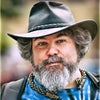A few months ago, filmmakers came to my workplace and interviewed me at length about four contemporary legends for a new documentary. That documentary, Killer Legends, airs this Sunday, March 16, on the Chiller Network. It promises to be an entertaining, informative and slightly creepy look at fear, crime and storytelling in the 20th century.
The film was directed by Joshua Zeman, creator of the award-winning documentary Cropsey. Josh's hypothesis was that certain contemporary legends (more popularly called "urban legends") might have grown from oral accounts of, or popular reactions to, true crime cases. In the film, he and producer Rachel Mills take to the road like a modern-day Scooby-Doo gang (minus hippies, nerds and dogs) to investigate famous crimes that may have legend connections. Along the way, they talk to law enforcement officers, profilers, historians, sociologists and even a Library of Congress folklorist (that would be me).
Are there sensationalistic things in the film? Sure there are! Josh repeatedly tells us that "the truth is more terrifying than we could ever imagine." Well, as Han Solo said, "I can imagine quite a bit!" Also, we might ask why they try to make sense of a crime scene at night by the light of inadequate flashlights, instead of just going in the daytime. The reason for these flourishes is clear: They aren't there to foster clear and precise discussion; they're there to make this an entertaining movie. And the good news is: They succeed.
Also, let's face it: the filmmakers' idea was not exactly new. For years, academics studying legends, and regular folks discussing such stories over dinner, have been floating the idea that there must have been a real hookman or a real threatened babysitter. Nothing tends to come of such speculation, because connections between crimes and legends usually can't be proven one way or another. So, you might ask, what's the point? I'd say there are two:
First of all, what they do that most speculators don't is get off their butts and go. They go where the crimes happened. They go where the cops have retired to and interview them. They go to the witnesses, the experts, the storytellers and the legend-trippers. Even more remarkably in this day and age, they go to the library! (Hey, old "Dear Abby" columns don't scan themselves!)
Second, whether you can prove a connection between the legends and the crimes or not, looking at each through the lens of the other affords a fascinating perspective. What about each legend is "truth-like?" What about each true crime is "legend-like?" What aspects of the crimes, and the legends, have caused them to become stories, narrated by ordinary people for a generation or more? These questions have been at the heart of folkloristic inquiry into the relationship between legends and truth since we've been studying legends. They're also some of the questions asked by this smart, fun and (yes) scary new documentary.
Check out the trailer below. I'm the talking head that comes up about 55 seconds in.
